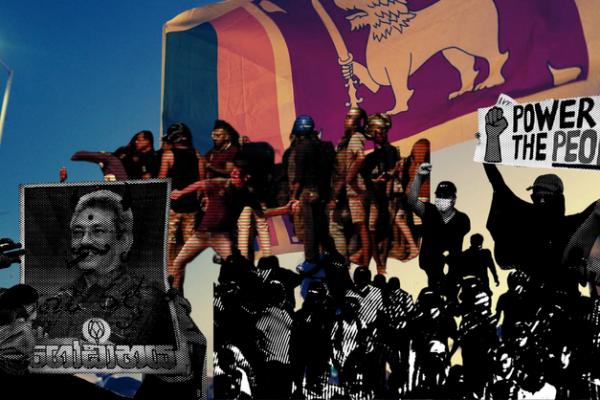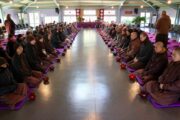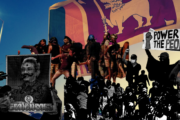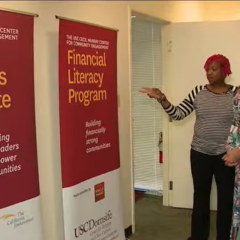This article was originally published by Jamhoor.
“Except for the home crowd cheering for our national team at an international cricket match, it was the first time I was seeing Sri Lankans united together for the same cause,” said a Sri Lankan friend as she recounted the first days of the 2022 protests calling for the resignation of President Gotabaya Rajapakse. My friend was here in Los Angeles for a brief visit, and we made time to catch up during a hike in the hills overlooking the city. As we enjoyed the sunset, our conversation inevitably turned to the unprecedented economic crisis unfolding back home in Sri Lanka.
My friend described herself standing at a busy intersection in Colombo, marveling at how, despite differences in religion, ethnicity, class and generation, Sri Lankans were expressing solidarity through protest in unprecedented ways. My friend, a minority Tamil Christian, felt hopeful that this moment signified a shift in the national consciousness, one that affirmed her belonging in the island nation. Indeed, protesters and activists are appealing for solidarity as a nation, proclaiming a new found unity that transcends race, ethnicity, religion and language. Images are shared on social media: protesting Muslim youth practicing salat prayers as non-Muslim youth stand guard to protect them from police violence; young Buddhist monks engaged in conversation with maulvis (Islamic teachers); and Catholic nuns sitting with Muslim women as they break their fast during the holy month of Ramadan. The unusual coincidence of Easter, Ramadan and the Sinhalese and Tamil New Year in the same month no doubt contributed to this hopeful collective spirit.
In April 2022, Sri Lanka defaulted on its external debt for the first time in its history. The lack of a sustainability strategy to address the $52B debt—along with economic mismanagement, corruption and incompetence in the public sector—contributed to the Sri Lankan state’s inability to manage the capitalist system and navigate its complex periodic boom-bust cycles.
Tens of thousands of people across the country have joined the protests and organized demonstrations, which are unprecedented in Sri Lankan history. In addition to the widespread discontent against the government for failing the economy, some Sinhala youth are beginning to speak about the reality of race and racism in Sri Lankan politics. The subtext of these proclamations is that racism, ethnic scapegoating and anti-minority violence are divide-and-rule strategies used by all the major political parties and have largely contributed to Sri Lanka’s current predicament.
It is too early to tell whether this rhetoric of unity is the blossoming of a new Sinhala youth political consciousness. At the very least, it is a recognition that the politics of their parents’ generation has failed. The scale of this new consciousness is an entirely new and promising phenomenon, one that needs to be supported by progressives in Sri Lanka. That said, in order to herald real systemic change, this consciousness must be coupled with a critical conversation around issues of race, religion and politics that underlie the current economic and political crisis. Specifically, what is required is a sharp critique of how the Sinhala Buddhist majority’s monopoly over governance directly contributes to the social exclusion, material dispossession and political marginalization of minority communities. Without such a critique and a program for political reform, calls for unity ring hollow. For national solidarity to be realized, we need to acknowledge and address systemic forms of racist violence and discrimination.
The Sri Lankan State is Racist by Design
For nearly half of its post-independence history, Sri Lanka was embroiled in a long and bloody civil war which has had a devastating impact on its ordinary people. Despite fervent hopes for peace and harmony, the end of the war in 2009 has only exacerbated the precarity of Sri Lanka’s minorities. For example, post-war militarization and state-sponsored Sinhala-Buddhist territorial expansion into northern and eastern Sri Lanka, traditionally Tamil and Muslim areas, has spurred communal contestations over land.
Hate speech, especially social media screeds targeting Muslims, have also become a major driver of tensions. During the civil war years, Tamils and Christians were considered the ethno-religious “others” who threatened the “righteous society” (dharmishtaka samajaya) of the Sinhala-Buddhist nation-state. The onset of the COVID-19 pandemic has revived post-war racist discourses which characterizes Muslims as “super spreaders” of the virus. Furthermore, the Rajapakse government instituted a nationwide moratorium on burials during the pandemic, ostensibly as a public health measure. Yet, Sri Lankan Muslims saw it as an intentional violation of their rights for Islamic burial.
The roots of this marginalization and tendency towards anti-minority violence run deep. In an incisive report about violence against minority communities, constitutional scholar and researcher Gehan Gunatilleke points out that:
both ultra-nationalist and relatively pluralistic governments have tolerated such violence to varying degrees, while consistently maintaining the overall impunity with which it is perpetrated. In this context, it appears that the Sri Lankan state itself embodies a certain structural dispensation towards ethno-religious violence.
The modern Sri Lankan state was not designed to include multi-ethnic, multicultural communities. Early attempts at constitution-making gave little importance to Ceylon as a multi-ethnic society. The introduction of a universal franchise as part of the 1931 Donoughmore Constitution lacked provisions to devolve power to minority communities. This led to an ethnically driven populist politics, which in turn led to a majoritarian democracy. Sociologist Stanley Tambiah noted how the Donoughmore reforms, rather than truly enfranchising Sri Lanka’s minorities, reified Sinhala-Buddhist majoritarian rule and monopoly over governance.
The origins of Sinhala-Buddhist majoritarian politics is intimately linked with the formation of the Sinhala-Buddhist identity during the colonial period. Indeed, there is little pre-colonial historical evidence to show that the local inhabitants had a Sinhala-Buddhist consciousness in its contemporary sense. Contrary to the beliefs of most Sinhala-Buddhist people, their identity is a fairly recent phenomenon, with its origins in the country’s 19th century Buddhist Revival. During this period, Buddhism started to emerge as a foundation upon which Sinhala nationalists started critiquing and agitating against colonial policy.
The colonial removal of pre-colonial state protections that were accorded to Buddhism significantly galvanized the anti-colonial nationalist movement. In this context, safeguarding Buddhism became central in the agenda of leading Buddhist Revivalists. For instance, in 1902, Sri Lankan Buddhist writer and revivalist Anagarika Dharmapala claimed that Sri Lanka was the island of the “Aryan Sinhalese”, tasked with preserving Buddhism in Sri Lanka, an island designated by the Buddha as the site where the purest expression of his doctrine would be preserved and propagated.
A core feature of the Sinhala-Buddhist Revivalist movement was the deployment of Buddhism as an ideology of resistance and social action against colonial rule. Race and religion became co-constituted, with Theravada Buddhism emerging as the primary identity marker of the “Sinhala nation.” This newly forged Sinhala-Buddhist identity was one of exclusion, targeting other ethno-linguistic and religious communities seen as foreign entities encroaching upon the “Sinhala-Buddhist nation”.
This exclusionary Sinhala-Buddhist identity has been deployed by Sinhala-Buddhist political elites for political mobilization since independence. A notable example being the political program of Prime Minister S.W.R.D Bandaranaike who declared Sinhalese the sole official language of the country in 1956. The Sinhala Only Act privileged the Sinhala community and excluded other linguistic minorities. This Act is an illustrative example of how Sinhala-Buddhism asserts monopolistic political rights in ways that directly contribute to the subordination of other ethno-religious communities as well as the indigenous groups. This nationalist ideology suggests that other ethno-religious communities live in Sri Lanka only due to Sinhalese Buddhist sufferance.
Institutionalized in the state, Sinhala Buddhist nationalist ideologies are now fully embedded in society. Article 9 of the current constitution (adopted in 1978) states that “the Republic of Sri Lanka shall give to Buddhism the foremost place and accordingly it shall be the duty of the State to protect and foster the Buddha Sasana, while assuring to all religions the rights granted by Articles 10 and 14(1)(e).” Tellingly, the framers of the 1978 constitution prioritized support for the buddhaśāsanaya, or Buddhism’s social and institutional manifestations, whereas other groups were merely accorded “religious rights.”
In addition to formal democratic institutions, the Buddhist Sangha, or community of monastics, exerts an enormous influence on governance. Generally, Sri Lankan governments are conferred legitimacy by the sangha in exchange for an undertaking to protect the buddhaśāsanaya. For example, upon getting elected a Sri Lankan President is expected to make an official visit to the sangha to get blessings. Beyond such symbolic gestures, the sangha has had an enormous impact on government policy. For example, the monastic community were vocal supporters of the state in the civil war and has actively agitated against the devolution of power to ethnic minority communities. Buddhist monks have also directly participate in anti-minority violence like that perpetrated by the Bodu Bala Sena group against the Muslim community. Despite their inordinate influence in politics, Sinhala people have been reluctant to actively denounce the role of the sangha in politics.
If we honestly hope to build a truly multi-ethnic Sri Lanka as part of the progressive youth-led political movement, we must target Article 9 of the constitution, the absence of constitutional provisions for the devolution of power to minorities and the outsized role of the Sangha in politics.
Older Social Movements Are Now More Relevant Than Ever
The sins of the Rajapakses do not begin with the economic mismanagement and negligence of 2019-2020 which caused the Sri Lankan economy to crash. As far back as 2005, with the tacit and explicit consent of the Sinhala political mainstream, the Rajapakses, along with their collaborators, began to build a military-intelligence machine that used enforced disappearances, torture, extortion, kidnapping, occupation and war crimes to advance its goals.
The brunt of this violence was borne by Tamil and Muslim communities, in the north and east. Though the civil war officially ended in 2009, the “peacetime” which the state inaugurated was marred by horrendous war crimes. To this day, almost every actor in the Sinhala political spectrum either approves of the way the war was ended or refuses to critically analyze the outcome.
In order to forge a new multi-ethnic Sri Lanka, youth activists with a progressive agenda need to reckon with the past and acknowledge that along with an economic disaster and a crisis of governance, we have a colossal ongoing human rights crisis. The struggles of the minority communities against dispossession, exclusion and state-violence are important because they highlight the specific tasks that must shape efforts to reform the state: accountability for war crimes, the devolution of power to minorities, investigating disappearances, eliminating torture, implementing meaningful mechanisms for reconciliation, to name just a few.
This sounds daunting, but there already exists an enormously rich reservoir of activists and organizations who have preserved invaluable knowledge and best practices inherited from decades of activism and emotional labor. This reformist movement would entail Sinhala activists working in solidarity with mothers of the disappeared, Tamil tea estate workers, communities evicted from their land by the Sri Lankan army, activists who oppose legislation that labels the state’s opponents “terrorists” and community members fighting rampant Islamophobia, among many others.
Towards Pluralism: The Critical Role of Sinhala Youth
It is a hard road ahead for progressives who want to realize this vision of a truly unified and democratic Sri Lankan politics. Particularly, the role of the Sinhala-Buddhist youth activists participating in these efforts is complicated by the fact of being Sinhala in a Sinhala dominated society where most of one’s social network and kinship ties are also with other Sinhalas. Sinhala-Buddhist identity is inextricable from political and economic power. Indeed, Sinhala-Buddhist identity has remained remarkably rigid and unyielding over the last 100 years, and no political party since Independence has had the temerity and imagination to challenge this bastion of privilege for the benefit of the Sinhala-Buddhist community.
Minorities in Sri Lanka are understandably skeptical about overtures to solidarity even from well-meaning Sinhala political activists. Furthermore, we cannot ignore the urgency of critically examining the terrifying military-intelligence apparatus that the Sri Lankan state has birthed. This machine of state violence now consumes more money than any other single item in the destitute nation’s annual budget.
There is no way to ignore or work around these institutional realities. Amending aspects of the current constitution — for example, by abolishing the 20th Amendment in order to curb Executive power — will still not alter the fundamentally discriminatory character of the Sri Lankan state instituted in other elements of the constitution. Similarly, rallying Tamils and Muslims under the Sri Lankan flag or the national anthem in the name of a common Sri Lankan identity will find little traction, as many Muslims and Tamils for rightfully see the flag and anthem as symbols of Sinhala-Buddhist racism. Instead, young reformers should address the fundamental problems at the very root of Sri Lankan institutions.
This means that the Sinhala-Buddhist community has a special responsibility in a re-imagined Sri Lanka. If the ideals of ethno-religious diversity and unity are to be realized, establishing parity between all ethno-religious communities is a necessary precondition. This requires the dismantling of the current status quo of the Sri Lankan state which institutionally and ideologically maintains the political, cultural and religious supremacy of the Sinhala-Buddhist community. No matter what form the institutions of a progressive future polity may take, disassembling this edifice of oppression is a fundamental prerequisite. But are Sinhala-Buddhist people ready to be just one of the many ethno-religious-linguistic groups living in Sri Lanka – to be equal, not superior? No political party since Independence has proved up to this task. Could the new coalition of activists finally make a difference?
Read the article and more at Jamhoor.
Nalika Gajaweera was a senior research analyst with the USC Center for Religion and Civic Culture through 2023.









